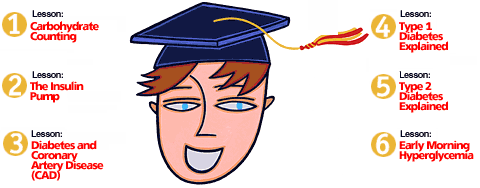



 |
|
|

|
|
Diabetes Lesson 4 - Type 1 Diabetes Explained 
Preventative measures are generally approached in two ways. Primary prevention occurs before the disease is diagnosed. Secondary prevention is given after the disease is triggered but before the person develops serious symptoms and complications. An example of primary prevention for type 1 diabetes in a person believed to be at risk for developing the disease, but who is symptom- free, would be a series of vaccinations against the viruses possibly associated with diabetes. Antiviral medication is also used in this case. The effectiveness of these measures is still under testing. Secondary prevention for type 1 diabetes is currently under many trials and is showing some success. Many of the treatments are based on the fact that people diagnosed with type 1 diabetes who also have high levels of autoantibodies are having their insulin-producing cells gradually destroyed. Because of the gradual disease progression, there is often a window of time to try preventative measures before more serious symptoms and complications develop. Outlined below are some methods of secondary prevention. Cytotoxic drugs: Cytotoxic drugs are used to increase the time between the appearance of antibodies and disease onset. These drugs combat the cells that could be destroying pancreatic cells. In studies, while this preventative measure didn't halt the onset of more severe diabetes symptoms, it did slow the appearance of symptoms. The problems associated with this method include severe and damaging side effects in some patients, as well as the drugs' tendency to attack normal cells, not just the faulty ones. Steroid drugs: The presence of high levels of autoantibodies before the onset of type 1 diabetes symptoms can be considered an autoimmune condition. Steroid drugs are often used to treat autoimmune diseases. Doctors have found that administering steroids can delay the onset of symptoms like excessive thirst and urination. Some problems with this procedure revolve around the harmful side effects of steroids. Small children are often the ones who develop type 1 diabetes and steroid drugs can stunt growth and cause infections. Additionally, the steroids themselves can precipitate elevated glucose levels, which can have the unwanted effect of worsening diabetes symptoms. Nicotinamide: This substance (a B vitamin) is currently under investigation and has shown some promising results in animal studies. It would be used to protect the insulin-producing pancreatic cells in people who are diabetes-prone. Some results have shown that 20% of patients taking nicotinamide did not develop diabetes symptoms and lost fewer insulin-producing cells. Diabetes Control and Complications Trial (DCCT): This 1993 study is the most comprehensive and crucial prevention study ever performed for type 1 diabetes. The results showed that maintaining very tight blood glucose control is possible, although challenging. The practice of keeping blood glucose as normal as possible was shown to prevent diabetes complications, like eye disease, kidney disease and nerve disease. For those already suffering with one or more complication, maintaining tight blood glucose control slowed the progression of the complication(s). Although doctors will often treat type 1 diabetes with this tight blood glucose control method, this approach increases the risk of serious hypoglycemia. Hypoglycemia, or low blood sugar, can result in weakness, anxiety and intense hunger at best, and convulsions, coma or death at worst. Assignment #3 Type 1 diabetes often strikes small children, which can present unique challenges to the parents of a diabetic child. Read this story of one father's journey in raising a child with diabetes. Page 1 2 3 4 Copyright © 2000-2025 savvyHEALTH.com. All rights reserved.
|
|
|
|||||||||||||||||
|
About savvyHEALTH | Privacy | Feedback | Home
http://www.savvyHEALTH.com/
All contents copyright © 1999-2025 savvyHEALTH, Inc. All rights reserved.
This internet site provides information of a general nature and is
designed for educational purposes only. If you have any concerns about
your own health, you should always consult
with a physician or other healthcare professional. Please review the Terms of Use before using this site. Your use of the site indicates your agreement to be bound by the Terms of Use.
|
|